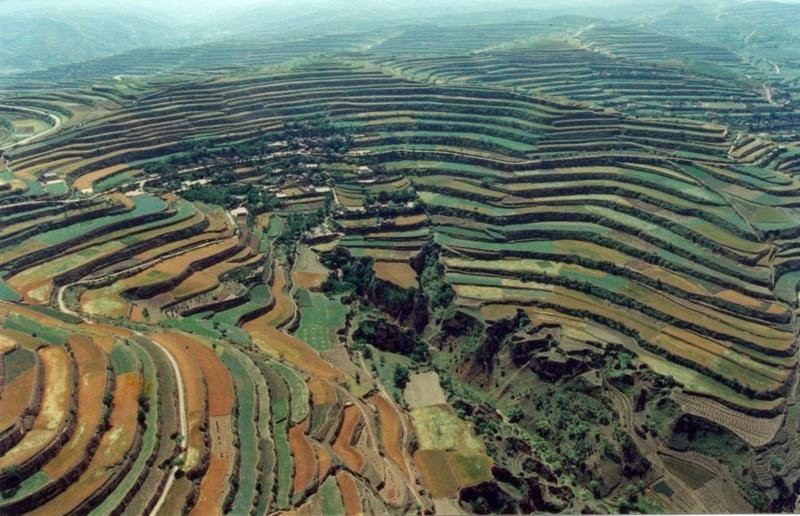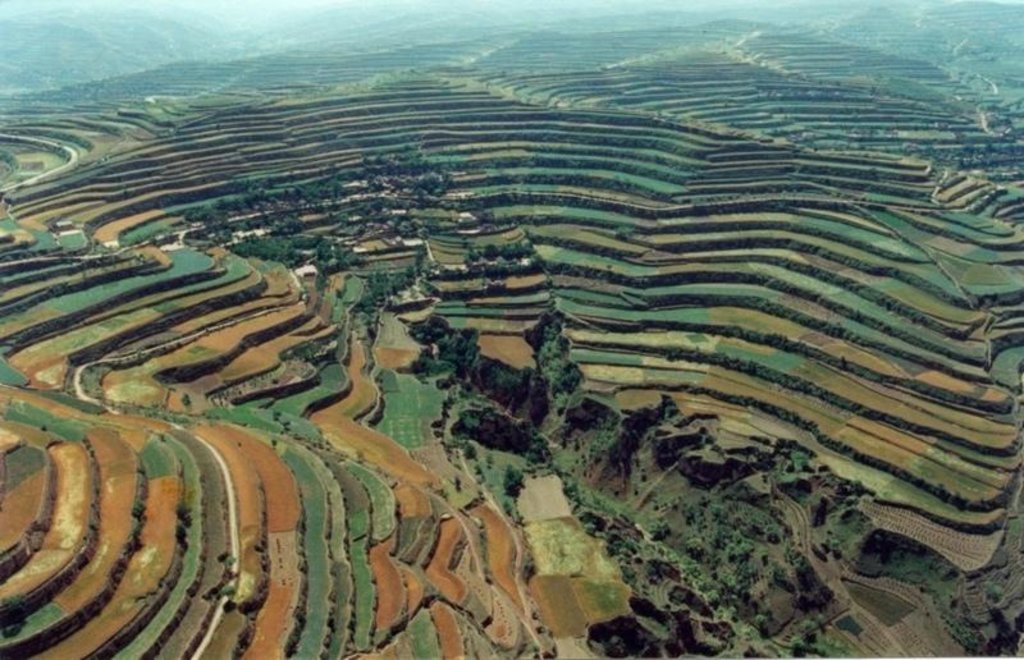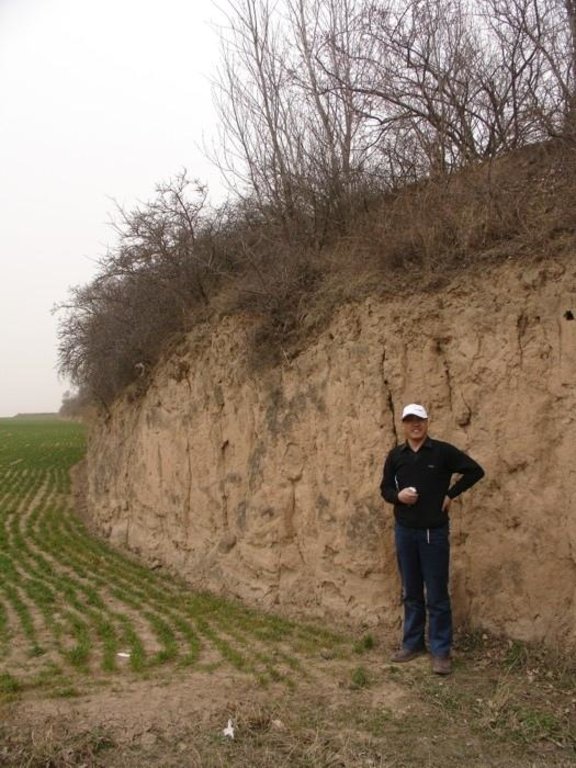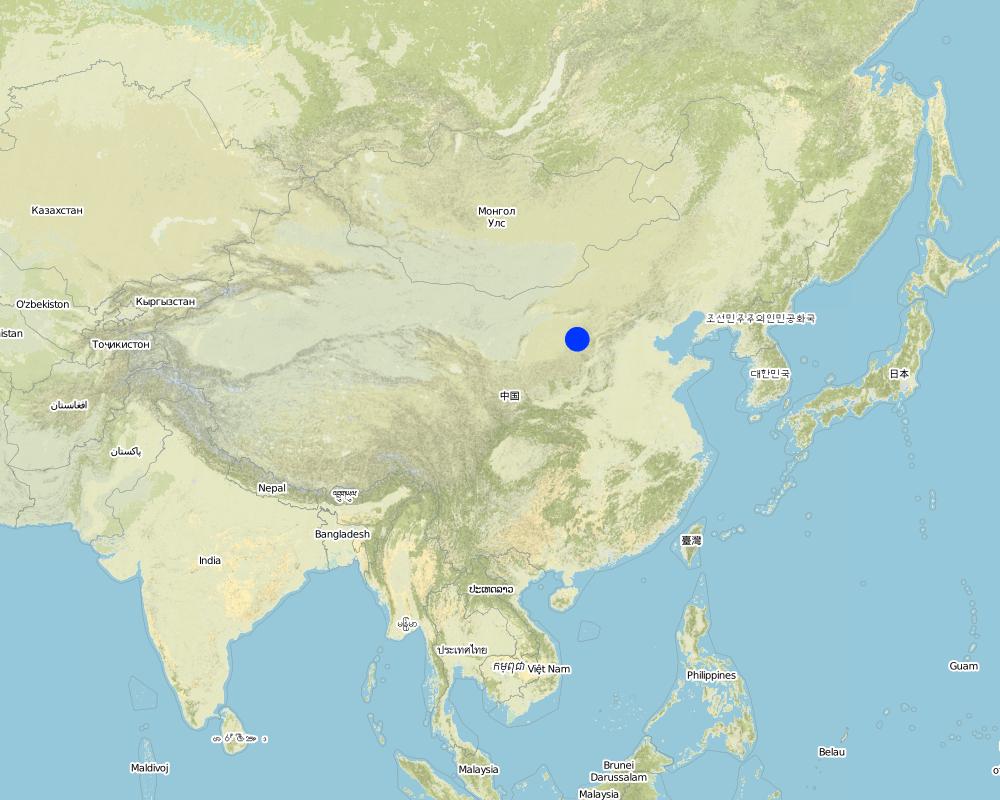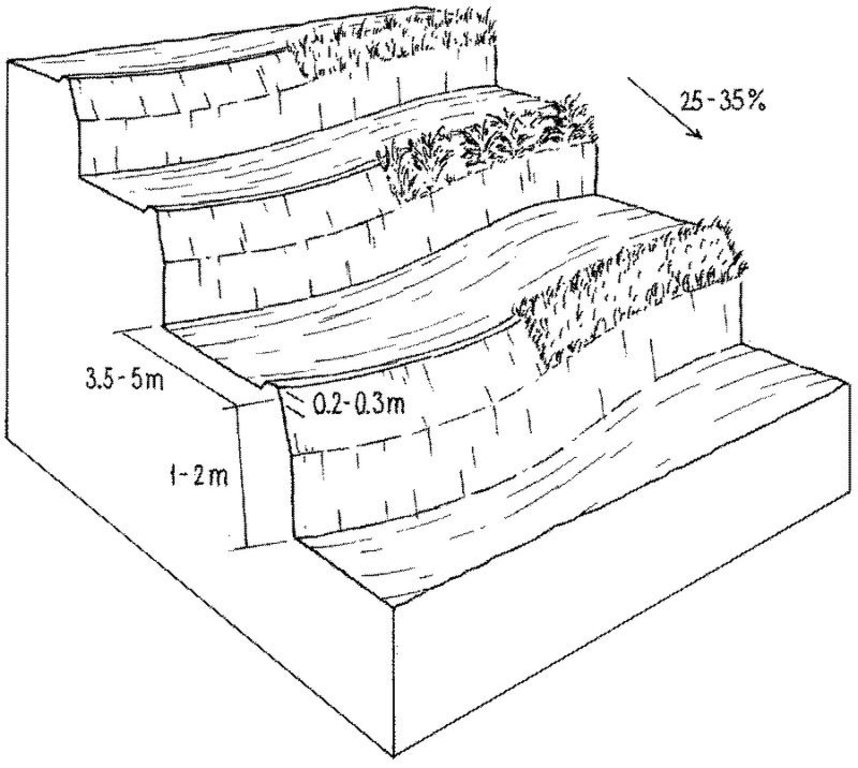Zhuanglang loess terraces [الصين]
- تاريخ الإنشاء:
- تحديث:
- جامع المعلومات: Yaolin Wang
- المحرر: –
- المراجعون: David Streiff, Deborah Niggli
technologies_1419 - الصين
عرض الأقسام
توسيع الكل طي الكل1. معلومات عامة
1.2 تفاصيل الاتصال بالأشخاص الرئيسيين لمصدر المعلومات والمؤسسات المشاركة في تقييم وتوثيق التقنية
متخصص في الإدارة المستدامة للأراضي:
متخصص في الإدارة المستدامة للأراضي:
Zhanguo Zhanguo
ISRIC
هولندا
متخصص في الإدارة المستدامة للأراضي:
اسم المشروع الذي سهّل توثيق/تقييم التقنية (إذا كان ذلك على صلة)
Book project: where the land is greener - Case Studies and Analysis of Soil and Water Conservation Initiatives Worldwide (where the land is greener)اسم المؤسسة (المؤسسات) التي سهلت توثيق/تقييم التقنية (إذا كان ذلك على صلة)
ISRIC World Soil Information (ISRIC World Soil Information) - هولندااسم المؤسسة (المؤسسات) التي سهلت توثيق/تقييم التقنية (إذا كان ذلك على صلة)
Department of Resources and Environmental Science, Beijing Normal University (Department of Resources and Environmental Science, Beijing Normal University) - الصيناسم المؤسسة (المؤسسات) التي سهلت توثيق/تقييم التقنية (إذا كان ذلك على صلة)
GEF/OP12 Gansu Project (GEF/OP12 Gansu Project) - الصين1.3 الشروط المتعلقة باستخدام البيانات الموثقة من خلال WOCAT
متى تم تجميع البيانات (ميدانيا)؟:
01/03/2006
يوافق جامع المعلومات والشخص (لاشخاص) الرئيسي لمصدر المعلومات على الشروط المتعلقة باستخدام البيانات الموثقة من خلال WOCAT:
نعم
1.5 الإشارة إلى الاستبيان (الاستبيانات) حول مناهج الإدارة المستدامة للأراضي

Terrace approach [الصين]
Highly organised campaign to assist land users in creating terraces: support and planning from national down to local level.
- جامع المعلومات: Yaolin Wang
2. وصف تقنيةالإدارة المستدامي للأراضي
2.1 وصف مختصر للتقنية
تعريف التقنية:
Level bench terraces on the Loess Plateau, converting eroded and degraded sloping land into a series of steps suitable for cultivation.
2.2 وصف تفصيلي للتقنية
الوصف:
The Loess Plateau in north-central China is characterised by very deep loess parent material (up to 200 m), that is highly erodible and the source of most of the sediment in the lower reaches of the Yellow River.
The plateau is highly dissected by deep gullied valleys and gorges. The steep slopes, occupying 30-40% of the plateau area, have been heavily degraded by severe top soil and gully erosion. Over the whole Loess Plateau approximately 73,350 km2 of these erosion prone slopes have been conserved by terraces.
In the case study area (Zhuanglang County) the land that is suitable for terracing has been completely covered. The total terraced area is 1,088 km2, accounting for 90% of the hillsides. The terraces were constructed manually, starting at the bottom of the slopes and proceeding from valley to the ridge. The terraces comprise a riser of earth, with vertical or steeply sloping sides and an approximately flat bed (level bench). Depending on farmers preference some terrace beds are edged by a raised lip (a small earth ridge) which retains rainwater, others remain without lip. The semi-arid climate does not require a drainage system. For typical hillside terraces on slopes of 25-35% the bed width is about 3.5-5 metres with a 1-2 metre riser, involving moving about 2,000-2,500 cubic metres of soil (see table of technical specifications). Generally the risers are not specifically protected, but there may be some natural grasses growing on the upper part. The lower part of the riser is cut vertically into the original soil surface, and has no grass cover, being dry and compact. However it is not erosion-prone since it has a stable structure.
Over most of the Loess Plateau, the soil is very deep and therefore well suited to terrace construction. In addition to downstream benefits, the purpose is to create a better environment for crop production through improved moisture conservation, and improved ease of farming operations. In an average rainfall year, crop yields on terraced land are more than three times higher than they used to be on unterraced, sloping land. The implication is that terrace construction - though labour intensive - pays back in only three to four years when combined with agronomic improvements (such as applying farm yard manure and planting green manure). Some farmers try to make the best use of the upper part of terrace risers by planting cash trees or forage crops - including Hippophae rhamnoides (seabuckthorn), Caragana korshinskii (peashrub) and some leguminous grass. This is locally termed ‘terrace bund economy’. The plants stabilise the risers and at the same time provides extra benefits.
2.3 صور التقنية
2.5 البلد/المنطقة/المواقع التي تم تنفيذ التقنية فيها والتي يغطيها هذا التقييم
البلد:
الصين
المنطقة/الولاية/المحافظة:
Gansu Province (Loess Plateau Region)
مزيد من التفاصيل حول الموقع:
Zhuanglang County
Map
×2.7 إدخال التقنية
حدد كيف تم إدخال التقنية:
- من خلال المشاريع/ التدخلات الخارجية
3. تصنيف تقنية الإدارة المستدامي للأراضي
3.2 نوع (أنواع) استخدام الأراضي الحالية حيث يتم تطبيق التقنية

الأراضي الزراعية
- زراعة سنوية
- زراعة الأشجار والشجيرات
المحاصيل الرئيسية (المحاصيل النقدية والغذائية):
major cash crops: peas
major food crops: wheat, maize, potato, millet, sorghum
perrenial tree and shrub cropping: apple, pear and peach; walnut
التعليقات:
Major land use problems (compiler’s opinion): Cultivation of unterraced hillside slopes leads to serious soil erosion and problems of downstream sedimentation.
Loss of topsoil and rainwater in uncontrolled runoff has contributed to declining crop yields.
3.3 مزيد من المعلومات حول استخدام الأراضي
إمدادات المياه للأرض التي يتم تنفيذ التقنية عليها:
- بعلية
عدد مواسم الزراعة في السنة:
- 1
حدد:
Longest growing period in days: 160Longest growing period from month to month: May to September
3.4 مجموعةالإدارة المستدامة للأراضي التي تنتمي إليها هذه التقنية
- التدابير المتقاطعة للمنحدرات
- terraces
3.5 انتشار التقنية
التعليقات:
Total area covered by the SLM Technology is 1080 m2.
3.6 التدابير التقنية في مجال إلادارة المستدامة للأراضي

التدابير البنيوية
- S1: المصاطب المتدرجة
التعليقات:
Main measures: structural measures
3.7 الأنواع الرئيسية من تدهور الأراضي التي تناولتها التقنية

تآكل التربة بالمياه
- الوزن(Wt): فقدان التربة السطحية/تآكل السطح
- (Wg):الانجراف الخلجاني/ الخلجان
- (Wo:) تأثيرات التدهور من مواقع أخرى

التدهور الكيميائي للتربة
- (Cn): تراجع الخصوبة وانخفاض محتوى المادة العضوية (غير ناتج عن الانجراف)

تدهور المياه
- (Ha): التجفيف
التعليقات:
Main type of degradation addressed: Wt: loss of topsoil / surface erosion, Wg: gully erosion / gullying, Wo: offsite degradation effects, Cn: fertility decline and reduced organic matter content, Ha: aridification
Main causes of degradation: soil management (Absence or bad maintenance of erosion control measures), other human induced causes (specify), poverty / wealth (Lack of captial), education, access to knowledge and support services (Lack of knowledge)
Secondary causes of degradation: labour availability (Lack of labour)
3.8 منع أو حد أو عكس تدهور الأراضي
تحديد هدف التقنية فيما يتعلق بتدهور الأراضي:
- اصلاح/إعادة تأهيل الأراضي المتدهورة بشدة
التعليقات:
Main goals: rehabilitation / reclamation of denuded land
4. المواصفات الفنية، وأنشطة التنفيذ، والمدخلات، والتكاليف
4.1 الرسم الفني للتقنية
4.2 المواصفات الفنية/شروحات الرسم الفني
Layout of level bench terraces on the Loess Plateau: the lower, vertical section is cut into the compacted soil. Natural grasses -
or planted grass/ shrub species - protect the more erodible and less steep upper part of the riser. The low ‘lip’ is optional.
Technical knowledge required for field staff / advisors: high
Technical knowledge required for land users: low
Main technical functions: reduction of slope angle, reduction of slope length, increase of infiltration, increase / maintain water stored in soil, water harvesting / increase water supply, retains runoff in-situ, reduces downstream flooding, reduces sediment deposition (a national/regional concern)
Structural measure: level bench terraces
Height of bunds/banks/others (m): 1-2
Width of bunds/banks/others (m): 3.5-5
Construction material (earth): loess parent material
Slope (which determines the spacing indicated above): 30%
4.3 معلومات عامة بخصوص حساب المدخلات والتكاليف
حدد كيفية احتساب التكاليف والمدخلات:
- حسب مساحة تنفيذ التقنية
الإشارة إلى حجم ووحدة المساحة:
ha
حدد العملة المستخدمة لحساب التكاليف:
- دولار أمريكي
4.4 أنشطة التأسيس
| النشاط | نوع التدبير | التوقيت | |
|---|---|---|---|
| 1. | Contour lines are marked out using pegs to show the location for the base of each terrace wall | بنيوية أو هيكلية | - |
| 2. | A trench is dug out along the marked line to serve as the foundation | بنيوية أو هيكلية | |
| 3. | A trench is dug out along the marked line to serve as the foundation | بنيوية أو هيكلية | - |
| 4. | The topsoil between the pegged lines is removed and put aside | بنيوية أو هيكلية | |
| 5. | See Annex T3: alternative ways of constructing the wall/riser, bed | بنيوية أو هيكلية | |
| 6. | The wall is raised slightly higher to form a lip to retain rainwater on the | بنيوية أو هيكلية | - |
4.5 التكاليف والمدخلات اللازمة للتأسيس
| تحديد المدخلات | الوحدة | الكمية | التكاليف لكل وحدة | إجمالي التكاليف لكل مدخل | % من التكاليف التي يتحملها مستخدمو الأراضي | |
|---|---|---|---|---|---|---|
| العمالة | Voluntary and paid (building terraces) | ha | 1,0 | 1200,0 | 1200,0 | 97,0 |
| العمالة | survey of labour | ha | 1,0 | 60,0 | 60,0 | |
| معدات | tools | ha | 1,0 | 30,0 | 30,0 | 100,0 |
| مواد البناء | earth | ha | 1,0 | |||
| إجمالي تكاليف إنشاء التقنية | 1290,0 | |||||
التعليقات:
Duration of establishment phase: 4 month(s)
4.6 الصيانة/الأنشطة المتكررة
| النشاط | نوع التدبير | التوقيت/الوتيرة | |
|---|---|---|---|
| 1. | 1. Repairing any collapses in the terrace wall – often caused by heavy | بنيوية أو هيكلية | |
| 2. | 2. Re-levelling of the terraces where necessary. This work is usually done by hand, using shovels and two-wheel carts. | بنيوية أو هيكلية |
4.7 التكاليف والمدخلات اللازمة للصيانة/للأنشطة المتكررة (سنويًا)
| تحديد المدخلات | الوحدة | الكمية | التكاليف لكل وحدة | إجمالي التكاليف لكل مدخل | % من التكاليف التي يتحملها مستخدمو الأراضي | |
|---|---|---|---|---|---|---|
| العمالة | Reparing terraces | ha | 1,0 | 25,0 | 25,0 | 97,0 |
| معدات | tools | ha | 1,0 | 10,0 | 10,0 | |
| مواد البناء | earth | ha | 1,0 | |||
| إجمالي تكاليف صيانة التقنية | 35,0 | |||||
التعليقات:
Calculations above are based on the following situation: slopes of about 25-35%, bed width of 3.5-6 m, and a 1-2 m high riser, involving moving about 2,000-2,500 cubic metres of soil. Note: these calculations are based on several years experience in Zhuanglang: that is why they differ in some respects from the standardised table in 2.4.1.
5. البيئة الطبيعية والبشرية
5.1 المناخ
هطول الأمطار السنوي
- < 250 مم
- 251- 500 ملم
- 501 - 750ملم
- 1,000-751 ملم
- 1,500-1,100 ملم
- 2,000-1,500 ملم
- 3,000-2,001 ملم
- 4,000-3,100 ملم
- > 4000 ملم
المنطقة المناخية الزراعية
- شبه قاحلة
5.2 طوبوغرافيا
متوسط الانحدارات:
- مسطح (0-2%)
- بسيط (3-5%)
- معتدل (6-10%)
- متدحرج (11-15%)
- تلال (16-30%)
- شديدة الانحدار(31-60%)
- فائقة الانحدار (>60%)
التضاريس:
- هضاب/سهول
- أثلام مرتفعة
- المنحدرات الجبلية
- منحدرات التلال
- منحدرات في السفوح
- قاع الوادي
المنطقة الارتفاعية:
- 100-0 متر فوق سطح البحر
- 500-101 متر فوق سطح البحر
- 1,000-501 متر فوق سطح البحر
- 1,500-1,001 متر فوق سطح البحر
- 2,000-1,501 متر فوق سطح البحر
- 2,500-2,100 متر فوق سطح البحر
- 3,000-2,501 متر فوق سطح البحر
- 4,000-3,001 متر فوق سطح البحر
- > 4000 متر فوق سطح البحر
وضح ما إذا كانت التقنية مطبقة على وجه التحديد في:
- غير ذات صلة
التعليقات والمواصفات الإضافية بشأن التضاريس:
Slopes on average: also rolling
Altitudinal zone: 501- 2000 m a.s.l.
Landforms: Also ridges
5.3 التربة
متوسط عمق التربة:
- ضحل جدًا (0-20 سم)
- ضحلة (21-50 سم)
- متوسطة العمق (51-80 سم)
- عميقة (81-120 سم)
- عميقة جدًا (> 120 سم)
قوام التربة (التربة السطحية):
- متوسط ( طميي، سلتي)
المواد العضوية في التربة السطحية:
- منخفضة (<1%)
إذا كان متاحًا، قم بإرفاق وصف كامل للتربة أو تحديد المعلومات المتوفرة، على سبيل المثال نوع التربة، الرقم الهيدروجيني/ درجة حموضة التربة، قدرة التبادل الكاتيوني، النيتروجين، الملوحة وما إلى ذلك.
Soil fertility: low-medium
Soil drainage / infiltration: good
5.6 خصائص مستخدمي الأراضي الذين يطبقون التقنية
التوجه السوقي لنظام الإنتاج:
- مختلط (كفاف/ تجاري)
الدخل من خارج المزرعة:
- 10-50% من جميع الإيرادات
أفراداً أو مجموعات:
- فرد/أسرة معيشية
اذكر الخصائص الأخرى ذات الصلة لمستخدمي الأراضي:
Off-farm income specification: working in construction, temporary employments
Market orientation mixed (subsistence and commercial): ash crop (peas) and food crops (potatoes, wheat, maize, millet, sorghum)
5.7 متوسط مساحة الأرض المملوكة أو المستأجرة من قبل مستخدمي الأراضي الذين يطبقون التقنية
- < 0.5 هكتارا
- 0.5 - 1 هكتار
- 1 -2 هكتار
- 2 - 5 هكتار
- 5 - 15 هكتار
- 15 - 50 هكتار
- 50 - 100هكتار
- 500-100 هكتار
- 1,000-500 هكتار
- 10,000-1,000 هكتار
- > 10,000 هكتار
هل يعتبر هذا نطاقًا صغيرًا أو متوسطًا أو واسعا (في إشارة إلى السياق المحلي)؟:
- على نطاق صغير
التعليقات:
Average area of land owned or leased by land users applying the Technology: < 0.5 ha, 0.5-1 ha, 1-2 ha
5.8 ملكية الأراضي، وحقوق استخدام الأراضي، وحقوق استخدام المياه
ملكية الارض:
- دولة
حقوق استخدام الأراضي:
- فردي
6. الآثار والتصريحات الختامية
6.1 الآثار التي أظهرتها التقنية في الموقع
الآثار الاجتماعية والاقتصادية
الإنتاج
إنتاج المحاصيل
الدخل والتكاليف
دخل المزرعة
آثار اجتماعية واقتصادية أخرى
easier field operation
production during the first year of implementation
الآثار الاجتماعية والثقافية
المؤسسات المجتمعية
التخفيف من حدة الصراع
الآثار الايكولوجية
التربة
رطوبة التربة
فقدان التربة
6.2 الآثار التي أظهرتها التقنية خارج الموقع
تدفقات مائية موثوقة ومستقرة في موسم الجفاف
الفيضان في اتجاه مجرى النهر
تراكم الطمي باتجاه مصب النهر
transported sediments
6.4 تحليل التكلفة والعائد
كيف يمكن مقارنة العوائد نسبة لتكاليف الإنشاء (من وجهة نظر مستخدمي الأراضي)؟
عوائد قصيرة الأجل:
سلبي
عوائد طويلة الأجل:
ايجابي جدا
كيف تتم مقارنة العوائدمع كلفة الصيانة/التكاليف المتكررة (من وجهة نظر مستخدمي الأراضي)؟
عوائد قصيرة الأجل:
إيجابي
عوائد طويلة الأجل:
ايجابي جدا
6.5 اعتماد التقنية
إذا كان متاحًا، قم بتحديد الكمية (عدد الأسر المعيشية و/أو المساحةالمغطاة):
NA
التعليقات:
There is no trend towards spontaneous adoption of the Technology
Comments on adoption trend: - The technology was implemented on a large scale through government initiated mass campaigns.
- The technology has generally not spontaneously spread beyond the areas developed through government intervention: the area that is suitable for terracing has been covered.
- Uncertainty over future land use rights limits the willingness of households to meet the costs of terrace construction.
6.7 نقاط القوة / المزايا / الفرص التي توفرها التقنية
| نقاط القوة/ المزايا/ الفرص من وجهة نظر مستخدمي الأراضي |
|---|
| Diversification of production: terracing makes cultivation of new cash crops possible: flax (for linseed oil), pears, apples, apricots, water melon; all these give high returns and thus make terrace construction profitable. |
| Benefits pay back the investments after only three to four years; approx. calculated on the basis of US$ 450 extra income per annum per hectare (for wheat) vs US$ 1,200 labour investment per hectare. |
| نقاط القوة/ المزايا/ الفرص من وجهة نظر جامع المعلومات أو غيره من الاشخاص الرئيسيين لمصدر المعلومات |
|---|
|
Reduced erosion, reduced loss of rainwater through runoff (increased in water use efficiency) and reduced fertility loss due to reduced slope angle and length How can they be sustained / enhanced? Maintain the quality of terrace construction. |
|
Increased soil moisture How can they be sustained / enhanced? Construct/maintain a terrace lip to retain rainwater on the terrace |
|
Increased crop production (before 1983 hunger and starvation in the area) How can they be sustained / enhanced? Combine with improved crop husbandry. |
| Easier field operations: the level terrace is easier to cultivate than the original hill slope. |
| Improvements of farmers’ living standard and decline in poverty stricken population. |
6.8 نقاط ضعف / مساوىء / مخاطر التقنية وسبل التغلب عليها
| نقاط الضعف/ المساوىء/ المخاطر من وجهة نظر جامع المعلومات أو غيره من الاشخاص الرئيسيين لمصدر المعلومات | كيف يمكن التغلب عليها؟ |
|---|---|
| Terrace riser can be destroyed by storms – and, sometimes, rodent holes | Good and timely repair and maintenance: planting upper parts of the risers with grass, bushes or even trees help to stabilise the risers but can lead to competition with the crop for water. |
| High cost/input for construction and establishment | Given the high erodibility of the soil and the steep slopes there is no real alternatives to labour-intensive terracing. |
| High loss of soil moisture due to evaporation from the soil surface. Wind erosion due to tillage | Protect soil surface for example by conservation agriculture – comprising permanent cover, crop rotation, reduced tillage – could be supplementary agronomic and vegetative options. |
| Decrease in production in first year | Apply manure and fertilizer. |
7. المراجع والروابط
7.2 المراجع للمنشورات المتاحة
العنوان، المؤلف، السنة، النظام القياسي الدولي لترقيم الكتب ISBN:
Terraces In China. Published By Ministry Of Water Resources Beijing, PRC.. 1989.
العنوان، المؤلف، السنة، النظام القياسي الدولي لترقيم الكتب ISBN:
Conservancy engineering budgetary estimateration. Issued by Ministry of water resources of PRC, Published by Yellow-river water conservancy publishing company, Zhengzhou, PRC. 2003.
العنوان، المؤلف، السنة، النظام القياسي الدولي لترقيم الكتب ISBN:
A Great Cause for Centuries – 50 Years in Water and Soil Conservation in China. Published by Department of Soil and Water Conservation, Ministry ofWater Resources Beijing, PRC. 2000.
العنوان، المؤلف، السنة، النظام القياسي الدولي لترقيم الكتب ISBN:
Dongyinglin, Changpiguang, Wangzhihua: Discussion on several questions onincreasing production of the terrace with two banks; Soil and Water Conservation Science and Technology in Shanxi. No. 1, p 36–37. 1990.
العنوان، المؤلف، السنة، النظام القياسي الدولي لترقيم الكتب ISBN:
Liumingquan, Zhangaiqin, Liyouhua:Pattern engineering of reconstruction the slope cropland; Soil and Water Conservation Science and Technology in Shanxi,No. 3, p 18–21. 1992.
العنوان، المؤلف، السنة، النظام القياسي الدولي لترقيم الكتب ISBN:
Liangqichun, Changfushuang, Liming: A study on drawing up budgetary estimate quota of terraced field; Bulletin of Soil andWater Conservation, Vol. 21, No. 5, p 41–44. 2001.
العنوان، المؤلف، السنة، النظام القياسي الدولي لترقيم الكتب ISBN:
Lixuelian, Qiaojiping: Synthetic technology of fertilizing and improving production on the newterrace. Terraces in China. Soil and Water Conservation Science and Technology in Shanxi, No. 3, p 13–14. 1998.
الروابط والوحدات المواضيعية
توسيع الكل طي الكلالروابط

Terrace approach [الصين]
Highly organised campaign to assist land users in creating terraces: support and planning from national down to local level.
- جامع المعلومات: Yaolin Wang
الوحدات المواضيعية
لا يوجد وحدات مواضيعية


